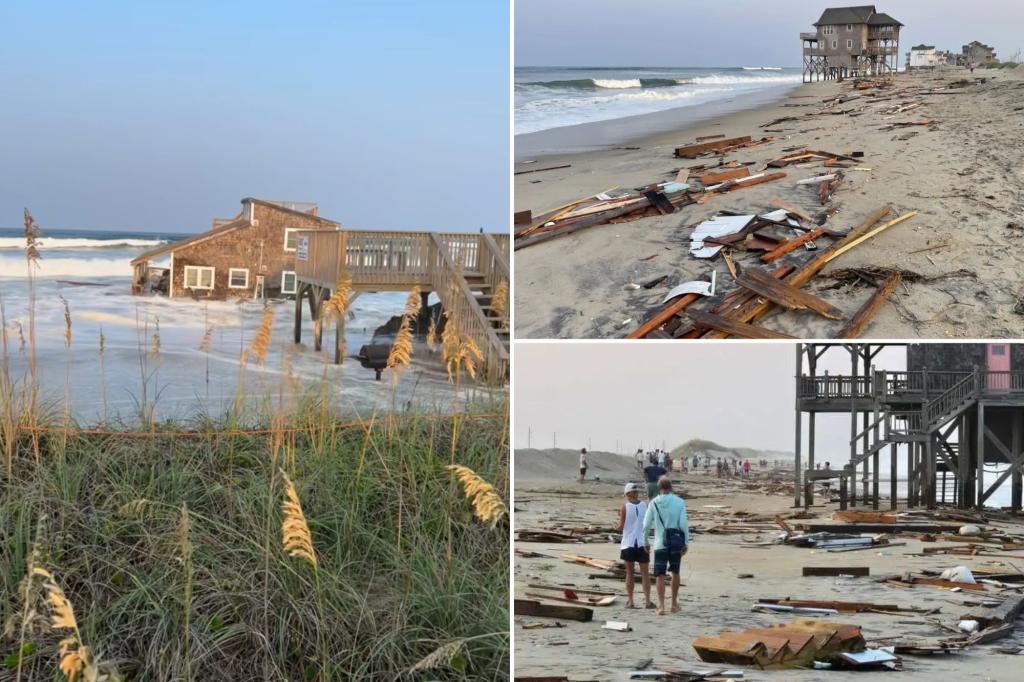Hurricane Ernesto caused a beach house to collapse and be washed out to sea in Rodanthe, North Carolina. The two-story house was situated on pilings and collapsed when the aggressive tide rushed past the property line. Debris from the home was seen floating alongside it, with most of it believed to have been swept out more than a dozen miles to sea. Experts suspect that more homes are at risk of collapsing into the Atlantic as Ernesto continues to grow stronger over the weekend.
Chicamacomico Banks Fire & Rescue officials warned that other homes in Rodanthe could collapse over the next few days as swell from Ernesto is expected to peak over the weekend. The rough weather conditions will likely continue to impact the area, and officials urged people to heed warnings and stay out of the ocean. Fortunately, no one was inside the collapsed beach house, and there were no reported injuries. This incident marks the seventh beach house to collapse on Seashore beaches in the past four years, indicating the increased vulnerability of the area to severe weather events.
The rapid shore loss in the Outer Banks, including Rodanthe, is attributed to a combination of factors such as winds, waves, tides, rising seas, and storms. These elements, along with hurricanes like Ernesto, have put many beach houses in the area at risk of collapse. Due to the risk of strong currents from Ernesto, beach access was shut down while officials wait for debris, and possibly more collapsed homes, to wash back up on shore. The vulnerability of the Outer Banks to extreme weather events highlights the ongoing challenges faced by the residents and officials in protecting these coastal properties.
The National Parks Service has been monitoring the erosion of the beaches in the Outer Banks, particularly at Cape Hatteras National Seashore beach in Rodanthe. The loss of homes in this area has been a recurring issue, with two homes collapsing on the same day in May 2022. This latest incident involving the beach house being carried out to sea by Ernesto’s strong tides underscores the ongoing threat posed by severe weather events. Efforts to address this issue include assessing the risk of other homes collapsing and ensuring public safety by closing access to the beach during dangerous weather conditions.
The impact of Hurricane Ernesto on the Outer Banks highlights the need for continued monitoring and adaptation to protect vulnerable coastal areas. The frequency of severe weather events like Ernesto requires residents and officials to be vigilant in ensuring the safety of beachfront properties. The loss of homes due to erosion and storms underscores the challenges faced by communities in these coastal regions. The response to this latest incident involves addressing the immediate safety risks, assessing the long-term implications for the area, and implementing measures to mitigate future damage caused by severe weather events.
In conclusion, the collapse of a beach house in Rodanthe, North Carolina, due to Hurricane Ernesto’s strong tides serves as a warning of the ongoing vulnerability of coastal properties in the Outer Banks. The increasing frequency and intensity of severe weather events pose a significant threat to these areas, leading to erosion, property damage, and potential risks to public safety. Efforts to address these challenges include monitoring beach erosion, assessing the risk of further collapses, and implementing measures to protect coastal communities. The response to the collapse of the beach house underscores the need for continued adaptation and preparedness to mitigate the impacts of severe weather events on vulnerable coastal areas like Rodanthe.


